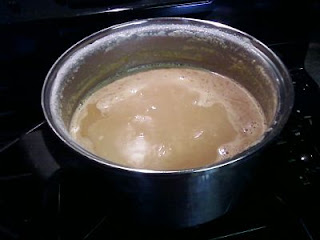I assumed there would be a lot of people attending, but I did not expect a traffic jam in the middle of the mountains. We inched along and watched the clock ticking off the minutes. The lower parking lot was already full, and we were directed up a hill. I panicked about the long walk, wishing I had worn my sneakers instead of dress shoes, until I saw the shuttle buses. It was close to 11 a.m. when I finally arrived at speaker check-in. As soon as Mike had his name badge, he was off and running to a session on sustainable energy, and I was asked to do a quick video interview about my upcoming session. I had no idea it would be so challenging to say something succinct about baking bread!
Both of my bread baking sessions went well and were filled to capacity. People were standing against the walls and sitting in the aisles. With only 45 minutes, I didn't have time to actually bake bread, so I talked about the basics of yeast bread, and I mixed up some dough so that people could see what it looks like when it's too sticky and when it's just right. Sorry, we don't have any pictures of the actual bread action. My camera was not cooperating. Almost every photo was horribly blurry.
My soap making session went well until the very end. I was in the middle of making soap when a woman stood up at the back of the room and said, "You have to stop now!" She was holding up a two-foot long sign that read, "STOP." Well, you can't just stop in the middle of making soap. Unfortunately, everyone started to get up, and many of them swarmed around me and my pot of mid-saponification oil-milk-lye mix. And they started asking me questions. Of course, they seemed like simple questions, which would have been easy to answer, if I were in a more relaxed environment. One person asked if she could put lavender flowers in soap. I explained that the heat from saponification would cause them to turn black and look like little bugs. Then a couple of other people were shouting questions about using herbs from opposite sides of where I was standing. And with lavender flowers still on the brain, I said, "No, you can't put herbs in soap." Of course, later I realized that is not even a yes-no question. Obviously, you can put herbs in soap, but depending upon your motivation, it may or may not give you the desired effect. For example, if you're doing it for scent, it's going to vary from one herb to another, but in general, it is really not going to work very well. Too bad I can't have a re-do of my last five or ten minutes.
 |
| A car fueled by wood |
The really exciting thing is that the Mother Earth News people are planning four -- yes, four -- fairs next year. Locations are not finalized yet, but they're looking at two on each side of the country, so it will be easier for people in different parts of the country to attend! It's obvious that everyone wants to do it again, because you heard lots of talk about "next year." I know I want to do it again!

















